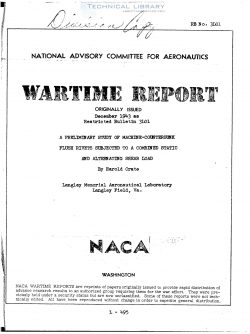naca-wr-l-495
- Version
- 106 Downloads
- 375.85 KB File Size
- 1 File Count
- April 2, 2017 Create Date
- April 2, 2017 Last Updated
A Preliminary Study of Machine Countersink Flush Rivets Subjected to a Combined Static and Alternating Shear Load

INTRODUCTION
In previous studies of the tightness and flushness
of machine—countersunk flush rivets (references 1 to 3)
it has been found that, if the countersunk head protrudes
above the sheet surface before the rivet is driven, a
much tighter riveted Joint is obtained than if the counter—
sunk head is below the sheet surface before the rivet is
driven. The purpose of the present investigation is to
study the effect of the height of the rivet head on the
number of cycles reguired to cause failure of a machine—
countersunk flush—riveted Joint under a combined static
and alternating shear load.
SPECIMENS AND TEST PROCEDURE
The specimens, which consisted of 24S—T aluminum—
alloy strips riveted with A17S—T rivets, were of two types
(fig. 1). Figure 3 illustrates the two methods of rivet—
ing investigated for each type of specimen. In the
ordinary flush—riveting procedure the height of the rivet
head above the sheet surface before driving hb was meas—
ured as described in reference 1 by means of a dial gage
graduated to 1/10000 inch. These rivets were driven
according to method 3 of reference.l, in which the manu—
factured head of the countersunk rivet is bucked on a
flat plate while the shank end is driven with-a vibrating
gun (fig. 2(a)). Three specimens of each type were fab—
,ricated according to the 310A procedure, method I of
reference 1; that is, by using round—head rivets inserted
from the back of the Joint and bucking the shank end into
the countersunk hole while the manufactured round head is
driven with a vibrating gun, as illustrated in figure
2(b). The countersunk rivet heads on the specimens
riveted by method E were milled off flush with the sheet
surface prior to testing.
The specimens were tested in the fatigue—testing
machine shown in figures 3 and 4. The specimen was
subjected to a static load of 38 pounds per rivet and,
in the case of tight rivets, to an alternating load of
137 pounds (*5 lb) per rivet at a frequency of 2700 cycles
per minute. The amplitude of vibration was measured in
each case with an Optical micrometer (fig. 5). On the
assumption that the weight vibrated with harmonic motion,
the alternating load was computed from the amplitude of
vibration, the frequency of vibration, and the mass of
the weight. A correct value of the alternating load was
obtained from this computation provided the rivets were
tight. In the case of loose rivets the motion of the
weights could no longer be considered harmonic and the
alternating load became an impact load of undetermined
magnitude.
| File | Action |
|---|---|
| naca-wr-l-495 A Preliminary Study of Machine Countersink Flush Rivets Subjected to a Combined Static and.pdf | Download |

Comment On This Post